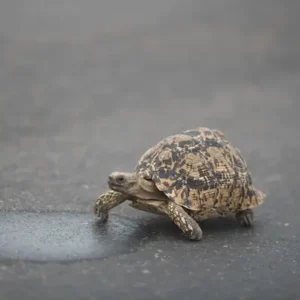History/Origin
Box turtles, members of the Emydidae family, boast a fascinating history that spans millions of years. Originating in North America, these resilient reptiles have navigated diverse environments, demonstrating remarkable adaptability across geological eras. Fossil evidence indicates their presence during different epochs, underscoring their evolutionary endurance.
Box turtles have thrived in habitats ranging from woodlands and meadows to grasslands, showcasing their ability to adapt to varying ecological niches. This extensive history not only highlights their longevity as a species but also underscores their integral role in the intricate tapestry of North American ecosystems.
Personality
Known for their calm demeanor, box turtles exhibit both independent and social behaviors. They can become accustomed to their owners and may even recognize them. However, they often appreciate their solitude and should not be overly handled.
Physical Appearance
- Size: Box turtles typically measure between 4 to 8 inches, with some species reaching larger sizes.
- Coat color: Their shells display a spectrum of colors, including shades of brown, olive, and yellow. Intricate patterns on the carapace contribute to their distinctive appearance.
Gender Differences
Male box turtles typically exhibit a concave plastron, or bottom shell, a notable feature that distinguishes them from females. This concavity serves a crucial role during mating, facilitating a more secure connection with the female’s shell.
Additionally, male box turtles often possess longer and thicker tails compared to their female counterparts. These distinguishing characteristics, particularly the concave plastron and tail dimensions, serve as key indicators for identifying the gender of box turtles.
Box Turtles Feed/Nutrition
Box turtles are omnivores, displaying a preference for a well-rounded and varied diet that includes:
- Insects: Rich in protein, insects like crickets and mealworms contribute to muscle development.
- Fruits: Offering natural sugars, vitamins, and antioxidants, fruits like berries and melons are beneficial.
- Vegetables: Leafy greens, carrots, and squash provide essential vitamins and fiber for overall health.
- Small Vertebrates: In the wild, box turtles may consume small vertebrates, enhancing their protein intake.
Balanced Nutrition
Ensuring a nutritionally balanced diet is crucial for their well-being:
- Calcium: Vital for shell health, calcium can be sourced from dark, leafy greens and supplements.
- Vitamins: Incorporating a variety of vegetables and fruits provides essential vitamins such as A and D.
- Protein: Insects and small vertebrates fulfill protein requirements for growth and maintenance.
Feeding Practices
Implementing a feeding routine that mirrors their natural foraging habits is essential:
- Regular Feeding: Offer food regularly, adjusting portion sizes based on age, size, and activity level.
- Hydration: Ensure a constant supply of clean water for hydration, especially in warmer climates.
Health
Gain insights into the potential health challenges faced by box turtles.
Hypovitaminosis A
- Causes: Insufficient vitamin A intake from a lack of leafy greens and vegetables.
- Symptoms: Swollen eyes, nasal discharge, and a decrease in overall vitality.
- Prevention/Treatment: Provide a well-balanced diet rich in vitamin A sources and consult a vet for supplementation if necessary.
Respiratory Tract Infections
- Causes: Exposure to cold temperatures, inadequate basking spots, or damp environments.
- Symptoms: Labored breathing, wheezing, and nasal discharge.
- Prevention/Treatment: Maintain proper temperatures, ensure a dry habitat, and seek veterinary care promptly.
Abscesses
- Causes: Wounds or injuries that become infected.
- Symptoms: Swellings, discharge, and reluctance to use affected limbs.
- Prevention/Treatment: Practice good hygiene, promptly treat injuries, and seek veterinary attention for proper drainage and antibiotic therapy.
Shell Infections
- Causes: Poor hygiene, injuries, or fungal/bacterial infections.
- Symptoms: Discoloration, soft spots, and abnormal shell growth.
- Prevention/Treatment: Maintain a clean habitat, address injuries promptly, and consult a vet for appropriate medication.
Gastrointestinal Parasites
- Causes: Ingestion of contaminated food or exposure to infected environments.
- Symptoms: Weight loss, diarrhea, and lethargy.
- Prevention/Treatment: Regular fecal exams, proper hygiene, and deworming under veterinary guidance.
Proactive Health Measures
- Regular Vet Check-ups: Schedule routine veterinary visits for overall health assessments.
- Optimal Habitat Conditions: Ensure the enclosure meets temperature, humidity, and cleanliness requirements.
- Balanced Diet: Provide a diverse and nutritionally balanced diet to support immune function.
Care and Grooming
Ensuring the well-being of box turtles involves replicating their natural habitat. Provide a spacious enclosure with hiding spots, a water source for hydration, and a basking area for thermoregulation.
Maintain optimal temperatures and humidity levels, mimicking their native environment. Regularly clean the habitat to prevent bacterial growth and offer a varied, well-balanced diet rich in vitamins and minerals. Monitor their health closely, addressing any signs of illness promptly.
Grooming includes keeping the shell clean and inspecting for abnormalities. This comprehensive approach to care promotes a healthy and thriving life for box turtles in captivity.
Rescue Groups
Several reputable organizations and sources are dedicated to the rescue and well-being of box turtles.
Consider reaching out to:
Species for Sale
When purchasing a box turtle, ensure it comes from reputable breeders such as follows. Prices may range from $50 to $300, depending on factors such as species and age.
Interesting Facts
- Winter Sleep: Box turtles don’t truly hibernate but instead undergo a state of torpor during colder months, conserving energy while remaining somewhat active.
- Nature’s Compass: Some box turtles showcase an impressive ability to navigate, with an internal magnetic compass helping them find their way over long distances.
Best For
Box turtles are best suited for dedicated reptile enthusiasts who are committed to providing the specific care and habitat requirements these unique creatures need. They can make fascinating and rewarding pets for those willing to invest time and effort in their care.
Top Names
| Male box turtle Names | Female box turtle Names |
| Rocky | Bella |
| Spike | Daisy |
| Leo | Luna |
| Max | Cleo |
| Gizmo | Mocha |










